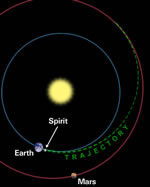
Image credit: NASA
Just 48 hours after launch, NASA’s Spirit spacecraft was 5.6 million kilometres away from Earth and on track for Mars. Just after launch, Spirit was rotating 12.03 times a minute and then thrusters on board reduced this to 2 rotations a minute. As the spin rate slowed down, the star scanners on Spirit were able to recognize various constellations and plot its position. The next hurdle will be when Spirit performs a trajectory-correction maneuver sometime soon. Spirit will arrive at Mars on January 4, 2004.
NASA’s Spirit spacecraft, the first of twin Mars Exploration Rovers, has successfully reduced its spin rate as planned and switched to celestial navigation using a star scanner.
All systems on the spacecraft are in good health. As of 48 hours after the June 10 launch, Spirit had traveled 5,630,000 kilometers (3,500,000 miles) and was at a distance of 610,000 kilometers (380,000 miles) from Earth.
After separation from the third stage of its Delta II launch vehicle on Tuesday, Spirit was spinning 12.03 rotations per minute. Onboard thrusters were used Wednesday to reduce the spin rate to approximately 2 rotations per minute, the designed rate for the cruise to Mars. After the spinning slowed, Spirit’s star scanner found stars that are being used as reference points for spacecraft attitude.
Navigators and other flight team members at NASA’s Jet Propulsion Laboratory, Pasadena, Calif., will be deciding soon when to perform the first of several trajectory-correction maneuvers planned during the seven-month trip between Earth and Mars.
Spirit will arrive at Mars on Jan. 4, 2004, Universal Time (evening of Jan. 3, 2004, Eastern and Pacific times). The rover will examine its landing area in Mars’ Gusev Crater for geological evidence about the history of water on Mars.
JPL, a division of the California Institute of Technology, manages the Mars Exploration Rover project for NASA’s Office of Space Science, Washington, D.C. Additional information about the project is available from JPL at http://mars.jpl.nasa.gov/mer and from Cornell University, Ithaca, N.Y., at http://athena.cornell.edu .
Original Source: NASA/JPL News Release
